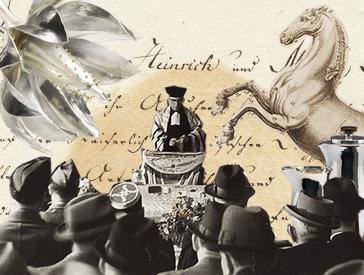“... there is, however, a definite want of a good Jewish cookbook.”
Complete Practical Cookbook for the Jewish Kitchen, by Bertha Gumprich, née Meyer. Fourth edition, significantly expanded and improved, Trier, about 1900, gift of Herbert and Elisabeth Simon, 2008
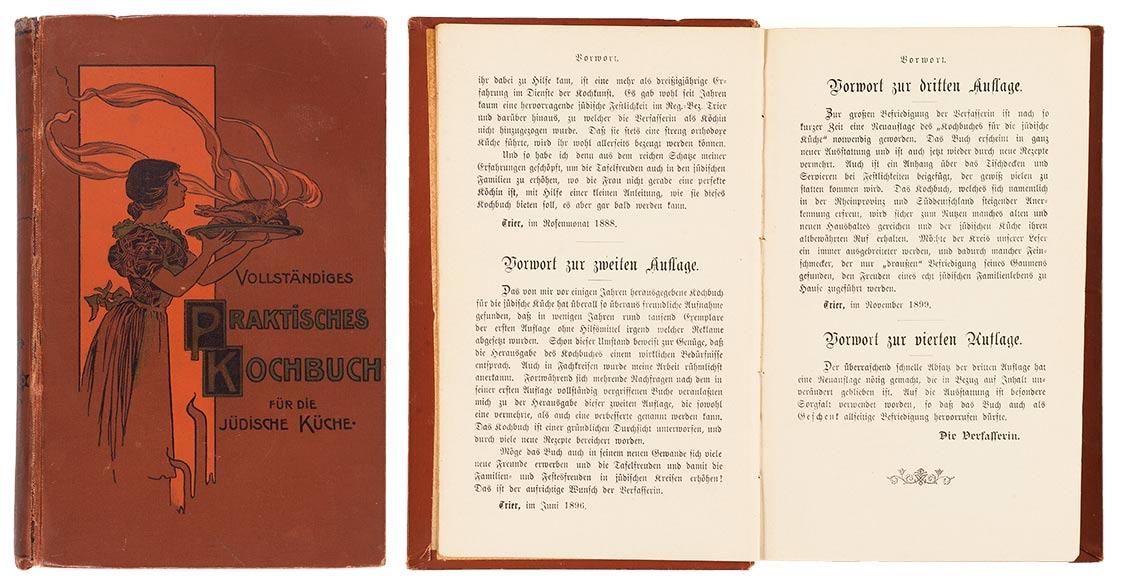
Vollständiges Praktisches Kochbuch für die jüdische Küche. Selbstgeprüfte und bewährte Rezepte zur Bereitung aller Speisen, Getränke, Backwerke und alles Eingemachten für die gewöhnliche und feinere Küche (Complete Practical Cookbook for the Jewish Kitchen. Self-tested and Reliable Recipes for the Preparation of All Dishes, Drinks, Cakes and Pastries, and All Manner of Preserves, for the Ordinary and Fine Cuisine), by Widow Joseph Gumprich, née Meyer. Fourth edition, significantly expanded and improved, Trier, Verlag von Kaufmann & Co., about 1900; Jewish Museum Berlin, accession BIB/206/0, gift of Herbert and Elisabeth Simon, photo: Roman März
In 2008, the Jewish Museum Berlin received a generous gift from Elisabeth and Herbert Simon. Along with kitchen utensils, tableware, porcelain and cutlery, the gift contained archival materials from Herbert Simon's grandparents Anselm Simon (1851–1928) and his wife Caroline Simon (née Hanau, 1856–1930), including the 348-page Vollständiges Praktisches Kochbuch für die jüdische Küche (Complete Practical Cookbook for the Jewish Kitchen) by Bertha Gumprich. The cookbook belonged to Caroline Simon, whose household was kept kosher. In it, she is sure to have found all sorts of inspiration and guidance on cooking and proper housekeeping.
The Cook and Author
If the presumed date, 1900, is correct for this fourth edition, it may have been published while the author was still alive. On the title page of this edition, her name is still given as “Widow Joseph Gumprich”. This may be why she is listed as “Josephine” in the contemporaneous Lexikon deutscher Frauen der Feder (Lexicon of German Women of the Quill), Berlin 1898. At this time, it was uncommon for women, and sometimes even men, to be named as authors. Publishing was done anonymously.
So, who was this Bertha Gumprich, who, as early as 1888, ventured to publish an author's edition of a cookbook of Jewish cuisine? Bertha Gumprich, who is only later referred to by this name, was a “cleaning lady” and cook. As such, she had already gathered 30 years of experience and knowledge in the Trier region by the time she self-published this cookbook. In the first edition from 1888, she notes:
“What helps her in this is her more than thirty years of experience in the service of the culinary arts. For years, there has hardly been a distinguished Jewish celebration in the county of Trier and beyond to which the author was not called in as a cook. The fact that she has always kept a strictly orthodox kitchen will be testified everywhere.”
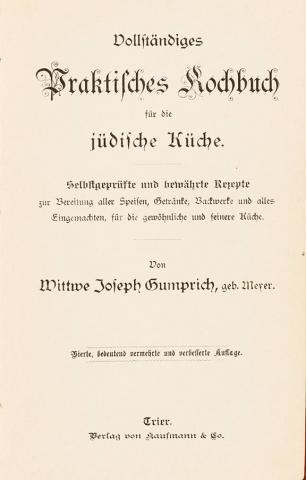
Complete Practical Cookbook for the Jewish Kitchen. Self-tested and Reliable Recipes for the Preparation of All Dishes, Drinks, Cakes and Pastries, and All Manner of Preserves, for the Ordinary and Fine Cuisine, by Widow Joseph Gumprich, née Meyer. Fourth edition, significantly expanded and improved, Trier, Verlag von Kaufmann & Co., about 1900; Jewish Museum Berlin, accession BIB/206/0, gift of Herbert and Elisabeth Simon, photo: Roman März
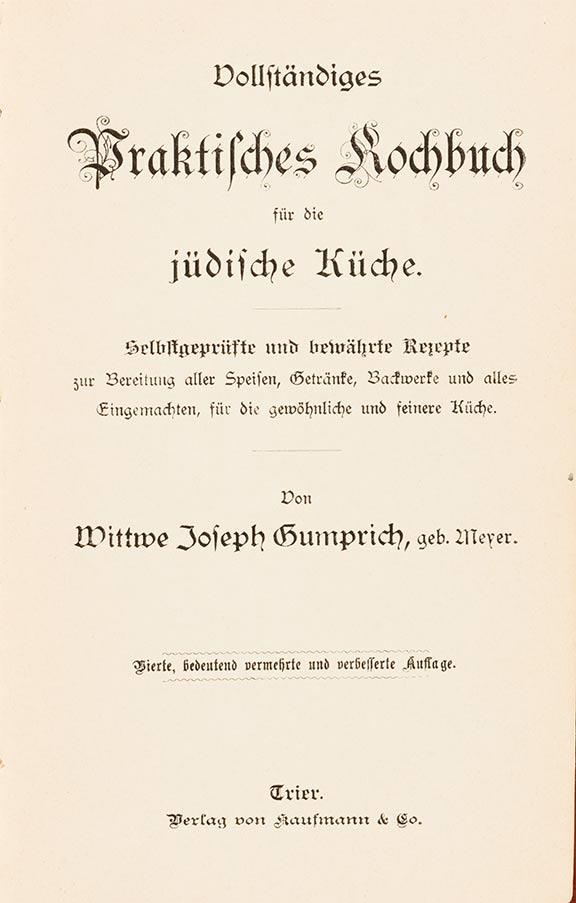 X
X
Complete Practical Cookbook for the Jewish Kitchen. Self-tested and Reliable Recipes for the Preparation of All Dishes, Drinks, Cakes and Pastries, and All Manner of Preserves, for the Ordinary and Fine Cuisine, by Widow Joseph Gumprich, née Meyer. Fourth edition, significantly expanded and improved, Trier, Verlag von Kaufmann & Co., about 1900; Jewish Museum Berlin, accession BIB/206/0, gift of Herbert and Elisabeth Simon, photo: Roman März
Forewords and Pancake Recipes
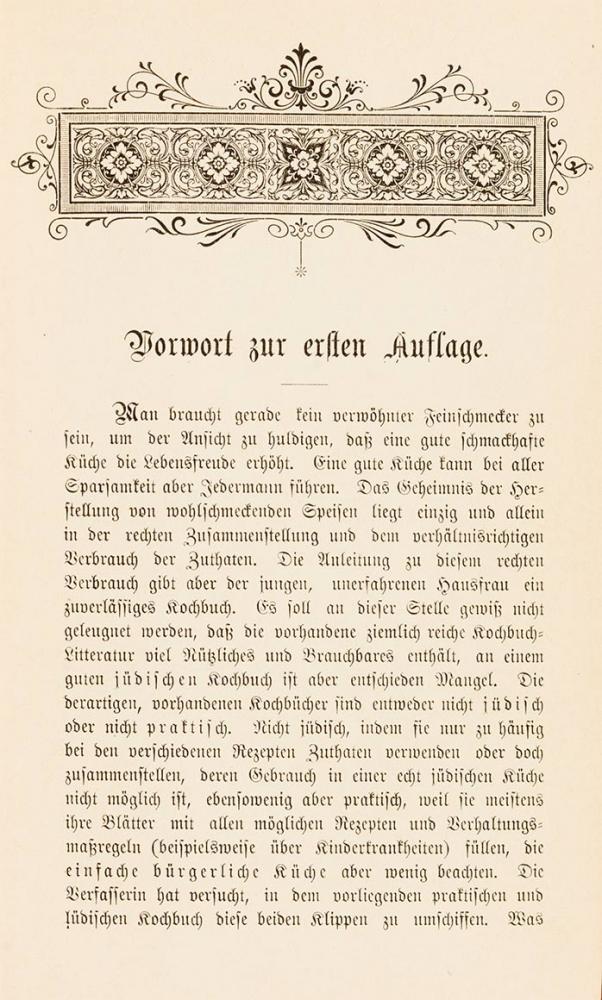
Foreword to the First Edition of the Complete Practical Cookbook for the Jewish Kitchen, by Bertha Gumprich, née Meyer; Jewish Museum Berlin, gift of Herbert and Elisabeth Simon, 2008
Foreword to the First Edition
One does not need to be the most discerning of gourmets to believe that good, tasty cuisine increases the joy of life. And anyone can cook well while being frugal. The secret to creating delicious dishes lies solely in the proper combination and proportionate use of ingredients. A reliable cookbook can give a young, inexperienced housewife guidance on this proper use. It should not be denied at this point that the quite rich cookbook literature available contains much that is useful and practical; there is, however, a definite want of a good J e w i s h cookbook. Such cookbooks as are available are either not J e w i s h, or not p r a c t i c a l. Not Jewish, in that the various recipes only too often employ or combine ingredients the use of which is not possible in a real Jewish kitchen, and not practical, because they mostly fill their pages with all manner of recipes and codes of conduct (for example concerning childhood illnesses) that s i m p l e m i d d l e-c l a s s kitchens seldom observe. The author has tried to avoid these two pitfalls in this practical and Jewish cookbook. What helps her in this is her more than thirty years of experience in the service of the culinary arts. For years, there has hardly been a distinguished Jewish celebration in the county of Trier and beyond to which the author was not called in as a cook. That she has always kept a strictly orthodox kitchen is certain to be testified everywhere. And so I have drawn from the rich treasure of my experience to increase the dining pleasure of even those Jewish families where the woman is not exactly a perfect cook, but can soon become one with the help of a little instruction, such as this cookbook is intended to provide.
Trier, the month of roses 1888

Foreword to the Second, Third, and Forth Edition of the Complete Practical Cookbook for the Jewish Kitchen, by Bertha Gumprich, née Meyer; Jewish Museum Berlin, gift of Herbert and Elisabeth Simon, 2008
Foreword to the Second Edition
The cookbook I published a few years ago for the Jewish kitchen found such friendly reception in all quarters that, in just a few years, around a thousand copies of the first edition were sold without the help of any advertising. This circumstance alone is proof that the cookbook's publication met a genuine need. My work was also met with praise in professional circles. Constantly increasing demand for the book's completely sold-out first edition has led me to publish this second edition, which can be considered both as an expanded and an improved one. The cookbook has been subjected to a thorough review and enriched with many new recipes.
May the book in its new guise win many new friends and increase the pleasures of dining and thus the family and festive joys of Jewish circles! This is the author's sincere desire.
Trier, June 1896
Foreword to the third edition
It is to the great satisfaction of the author that a new edition of the “Cookbook for the Jewish Kitchen” has become necessary after such a short time. The book appears in an entirely new design and has once more been expanded with new recipes. An appendix on setting the table and serving at celebrations is also included, which will surely be of use to many. The cookbook, which has enjoyed growing recognition particularly in the Rhine Province and Southern Germany, will surely benefit some old and new households, and preserve the Jewish cuisine's time-honored reputation. May the circle of our readership continue to expand, and through this, may many a gourmet who has only been able to satisfy his palate “outside” be introduced to the joys of genuine Jewish family life at home.
Trier, November 1899
Foreword to the fourth edition
The surprisingly quick sales of the third edition have made a new edition necessary, which remains unchanged in terms of its contents. Special care has been taken with the design so that the book may evoke all-round satisfaction as a gift.
The author.
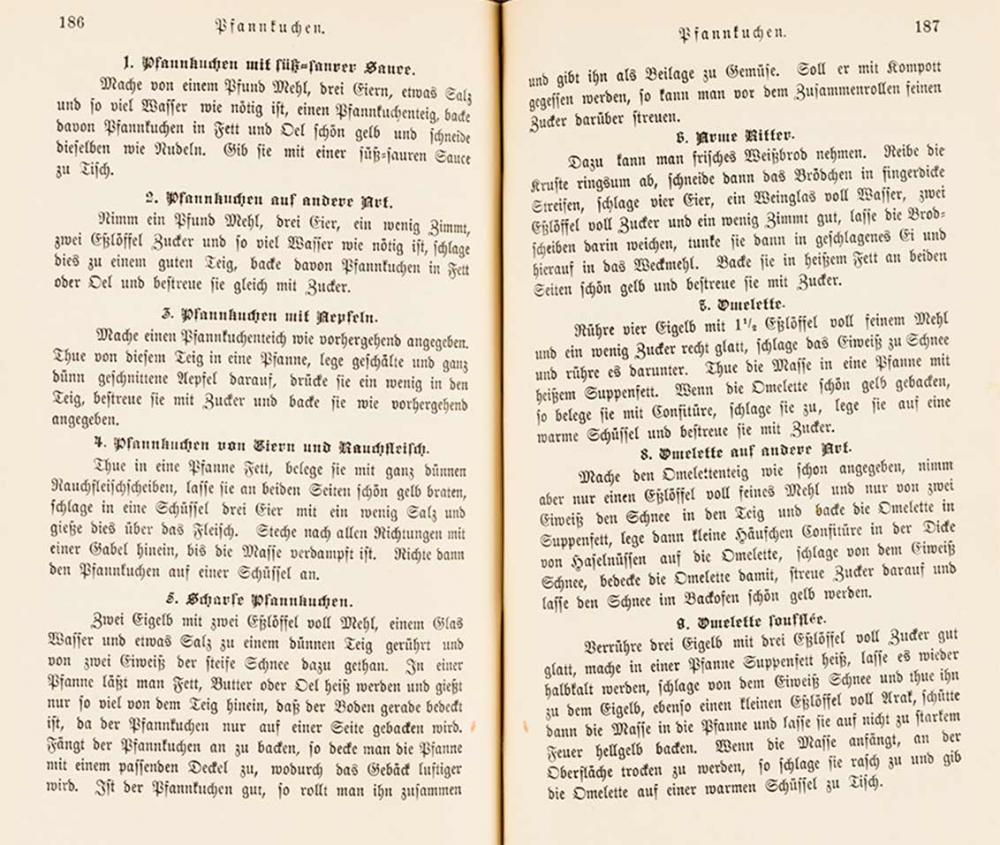
Recipes for Pancakes from the Complete Practical Cookbook for the Jewish Kitchen, by Bertha Gumprich, née Meyer; Jewish Museum Berlin, gift of Herbert and Elisabeth Simon, 2008
1. Pancakes with a Sweet-and-Sour Sauce
Make a pancake batter from a pound of flour, three eggs, a touch of salt and as much water as required to make a batter; use it to cook pancakes in fat and oil until nice and golden, and then cut them into noodles. Serve them with a sweet-and-sour sauce.
2. Pancakes in a Different Way
Take a pound of flour, three eggs, a little cinnamon, two tablespoons of sugar and as much water as required to beat it to a good batter; use it to cook pancakes in fat or oil, then immediately sprinkle with sugar.
3. Pancakes with Apples
Make a pancake batter as explained above. Put some of this batter in a pan, lay peeled very thin apple slices on top and push into the batter a little, sprinkle with sugar and cook as explained above.
4. Pancakes with Egg and Smoked Meat
Put fat into a pan, cover it with very thin slices of smoked meat and fry on both sides until golden. In a bowl, beat three eggs with a little salt and pour this over the meat. Prick with a fork in all directions until the mixture is no longer runny. Then serve the pancake on a dish.
5. Hot Pancakes
Mix two egg yolks into a thin batter with two tablespoons of flour, a glass of water and a little salt; add two egg whites that have been beaten into stiff peaks. In a pan, heat fat, butter or oil, then pour in just enough of the batter so that the bottom of the pan is covered, because the pancake will only be cooked on one side. When the pancake has started to cook, cover the pan with a suitable lid to make the pancake fluffier. When the pancake is ready, roll it up and serve it as an accompaniment to vegetables. If it is to be eaten with compote, it can be sprinkled with fine sugar before being rolled up.
6. Poor Knight (French Toast)
Fresh white bread can be used for this. Rub off the crust all the way around, then cut the bread roll into finger-width strips. Thoroughly beat together four eggs, a wine glass full of water, two tablespoons of sugar and a little cinnamon. Allow the slices of bread to soften in this mixture, then dip them first in beaten egg and after that in breadcrumbs. Fry in hot fat on both sides until nicely golden, and sprinkle with sugar.
7. Omelet
Beat four egg yolks with 1 ½ tablespoons of fine flour and a little sugar until very smooth. Beat the egg whites into peaks and stir in. Put the mixture in a pan with hot soup fat. When the omelet is nice and golden, cover it with jam, fold it over, put it on a warm dish and sprinkle with sugar.
8. Omelet in a Different Way
Make the omelet batter as described above, but only use one tablespoon of fine flour and only put two beaten egg whites into the batter. Cook the omelet in soup fat, then place little heaps of jam the size of hazelnuts on the omelet, beat the other egg whites into peaks, cover the omelet with this mixture and sprinkle with sugar. Allow the beaten egg whites to go nicely golden in the oven.
9. Omelet Soufflé
Mix three egg yolks with three tablespoons of sugar until nice and smooth. Heat soup fat in a pan until hot, and then allow it to cool down a little. Beat the egg whites into peaks and add to the egg yolk along with a small tablespoon of Arak. Then pour the mixture into the pan and allow it to cook over a not-too-hot flame until lightly golden. When the mixture starts to become dry on the surface, quickly fold it over and serve the omelet on a warm dish.
A Sellout
There was no shortage of cookbooks at this time – except, apparently, when it came to those for the Jewish kitchen. Although statistics suggest that there were only 823 Jews living in Trier in 1895, it appears that Bertha Gumprich's instincts were right in her decision to publish. The quick succession of editions are proof of this: the first edition of 1000 copies was published in 1888, a second edition in 1896, a third edition in 1899, and a fourth edition was published without a year, but presumably in 1900, by Verlag von Kaufmann & Co. in Frankfurt am Main.
After Bertha Gumprich's death, another six editions were brought out by the same publishing house. During the period of National Socialism, many copies went missing and the book faded into obscurity. It was only rediscovered through the research of the Jewish studies scholar Annette Haller. In 2002, a reprint of the 2nd edition from 1896 was published by the Universitätsbibliothek Freiburg. In Trier itself, no copies remain in either private collections or the regional libraries.
Middle-Class Dining Pleasures
Gumprich strives to write reliable and middle-class instructions that enable uninformed and inexperienced women to manage or even to direct a household. She wants to enhance the "dining pleasures and thus the family and festive occasions of Jewish circles!"
With occasional references to "Christian cuisine" she also accommodates the readership beyond Jewish communities.
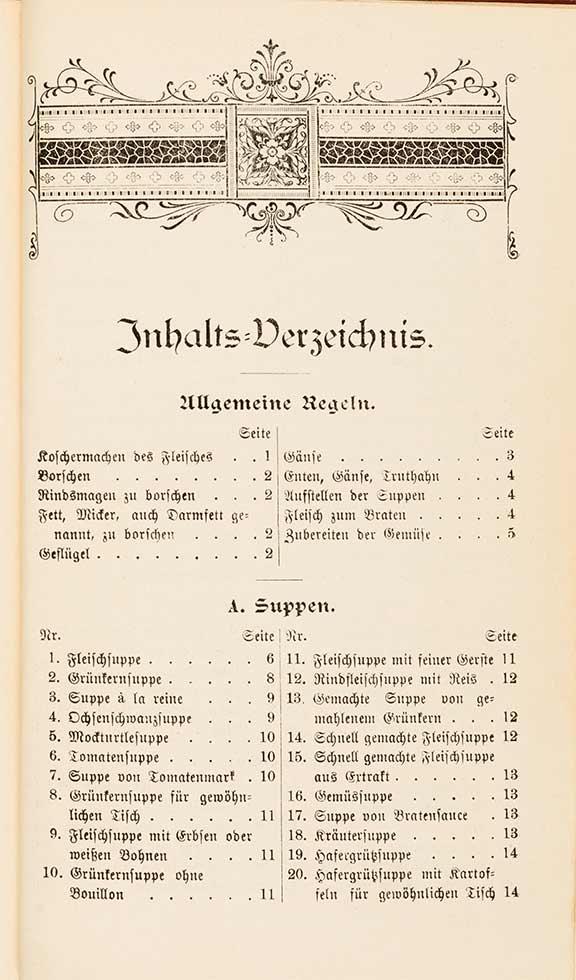 X
X
Table of Contents of the Complete Practical Cookbook for the Jewish Kitchen, by Bertha Gumprich, née Meyer. Fourth edition, significantly expanded and improved, Trier, about 1900; Jewish Museum Berlin, accession BIB/206/0, gift of Herbert and Elisabeth Simon, photo: Roman März
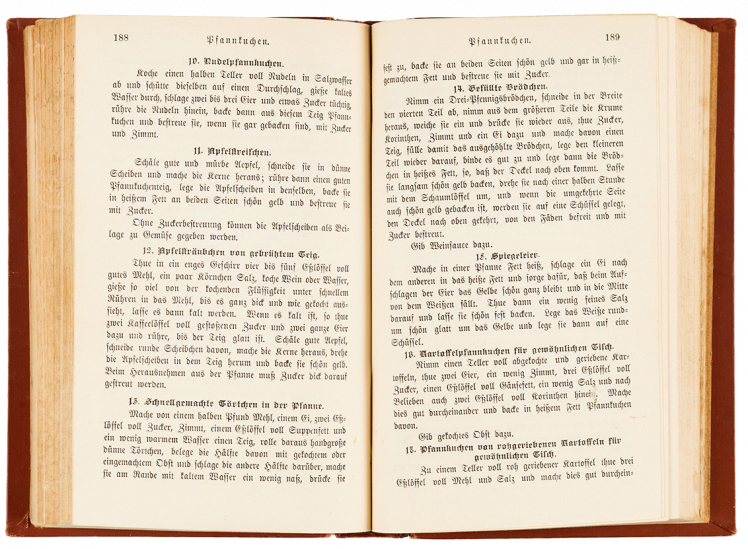
Recipes for various pancakes from the Vollständiges Praktisches Kochbuch für die jüdische Küche (Complete Practical Cookbook for the Jewish Kitchen) by Bertha Gumprich; Jewish Museum Berlin, accession. BIB/206/0, gift of Herbert and Elisabeth Simon, photo: Roman März
Impoverished Circumstances
Despite the publishing success of many editions and interest in the Jewish community and beyond, the author lived in impoverished circumstances and did not make much profit from the cookbook during her lifetime. This is shown in an entry in the above-mentioned lexicon: “May the book find many friends and so lead to an improvement in the poor old woman's living situation.” This was not to be granted, for she died in August 1901 “after long suffering endured patiently”.
We would like to commemorate Bertha Gumprich and her work, and it seems fitting to do so with a recipe from her cookbook.
Recipe for Noodle Pancakes
Boil half a plateful of noodles in salted water, pour it into a colander and rinse with cold water. Thoroughly beat two to three eggs and a little sugar and stir in the noodles. Cook pancakes using this batter and sprinkle them with sugar and cinnamon when they are cooked through.
Ulrike Sonnemann, Head Librarian
Citation recommendation:
Ulrike Sonnemann (2021), “... there is, however, a definite want of a good Jewish cookbook.”. Complete Practical Cookbook for the Jewish Kitchen, by Bertha Gumprich, née Meyer. Fourth edition, significantly expanded and improved, Trier, about 1900, gift of Herbert and Elisabeth Simon, 2008.
URL: www.jmberlin.de/en/node/8347
Selected Objects: Library (5)











